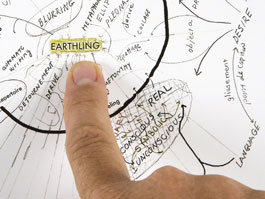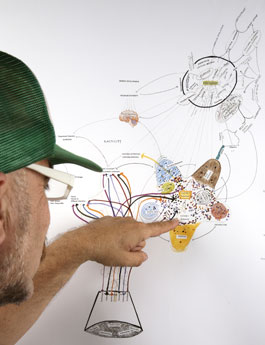
The diagram is indeed a chaos a catastrophe but it is also a germ of order or rhythm. It is a violent chaos in relation to the figurative givens, but it is a germ of rhythm in relation to the new order of the painting. As Bacon says, it “unlocks areas of sensation.
Francis Bacon: The Logic of Sensation, Gilles Deleuze
The diagram or abstract machine is the map of relations between forces, a map of destiny, or intensity, which proceeds by primary non-localizable relation and at every moment passes through every point, or rather in every relation from one point to another.
Foucault, Gilles Deleuze
I approach the Earthling Drawing that is tacked to my wall. It is at some distance now and what I see is a multicolored abstract drawing that covers the paper with lines, marks and points distributed unevenly. Several, separate areas are demarcated like small continents. These parts, of which there are four, have developed over the past 8 years. They have been drawn, overdrawn, redrawn, extended and edited. As such, the drawing is an impermanent condition of a still evolving process! The first part is called The Cultured Brain Drawing and fills the space in the middle right hand section. It looks like an amoeba with pseudo pods. The second part is called The Global Generator and it is funnel shaped and situated at the bottom. The third section is called The Becoming Brain Drawing and is found on the far left. Finally, The Earthling Drawing is found in the upper right hand corner and was the most recent addition.

As I continue my approach I realize that there are words that adorn its’ arabesque forms. I first point and then deliver my finger quite randomly to a location towards the center left center. This initial touch begins a drifting process in which my finger tip is a compass navigating a route or root to other locations and places as a tracing. My finger for instance my finger alights first in The Cultured Brain Drawing on Culture 1 (Extensive Culture). It then moves up along a tracing connecting it to Culture 2 (Intensive Culture). The arrow is bidirectional and connotes that each is symbiotic and contained in the other as nested symbolic gestures (see figure 2).
Intensive Culture (Culture 2) is the product of an ontologic process that emanates from Culture 1 (Extensive Culture) and is defined by a multiplicitous, non-linear, rhizomatic processes, immaterial labor as a virtuoso performance and the conditions of the social brain. It has supplanted its predecessor Culture 1 (Extensive,Culture) defined here as a set of conditions which has been formed according to a different set of coordinates and logics. Ones, which are equally divisible, linear, narrative in which labor concerns the production of a real objects tethered to the actions of the physical body. Each is situated in a diffuse milieu of The Cultured Brain Drawing signified by random colored dots made with the end of a blunt magic markers, which are diffusely distributed throughout. Closer inspection unveils a series of flowing multicolored lines swooping in from the bottom left where after entering the inside of the drawing they seem to fragment.
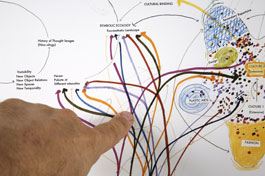
By a reverse tracing, the finger follows the multiple multi-colored curved lines back down towards an upside-down, cone-shaped funnel situated below. I refer to this part of the drawing as The Global Generator. The cone is divided into two parts. The top is the generative source of the colored lines and upon close inspection one can see that they are labeled according to the immaterial relations such as the social, political, historical, economic, psychological and unknown that they designate. Each, in itself, is in constant flux and is caused by the incessant shifting of internal differences which form its structure constituted by, for instance, the logic of the symbolic conditions that give it meaning. Moving the eye along each sinewy strand -in fact the eye has learned to follow the finger- one begins to notice lightly traced eddies and whirlpools that represent feedback and feed-forward circuits that link all the relations together and which through a series of tight junctions, open conduits which allow for the exchange of internalized elements, allowing information to diffuse from one relation to the other, producing differences that need to be adjusted to.
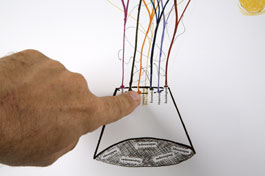
Forming the substructure of the funnel are a series of labels like, Ethnocape and Mediascape that refer to the mutating conditions of culture in the global setting adopted from the work of Arjun Appadurai Modernity at Large: Cultural Dimensions of Globalization. They form the foundation of the cultural shifts from Culture 1 to Culture 2.
I resume my drift and now move my finger again upward and rejoin the The Cultured Brain Drawing. My finger tip, like a vagabond circulates throughout the terrain of the inside, finding shelter under its nested regularities labeled Plastic Arts, Architecture, Technology and The Film Arts. Like the Visual Culture they together help to produce each other, in a condition of flux as they respond to the same immaterial conditions. Each attempts, as best it can, using its own histories, performances, apparatti, techniques and materials to make its own image. An image that is a present and past tense simultaneously. An image of the past, which is reflected in the history of all its past images, as each travels along its own journey of time. How design of jewelry and religious artifacts used in burial rights has changed since the time of the Cro Magna! In the present tense, each is the consummated activity of the immaterial relations that it embodies and that, like a mirror, reflects back to be cogitated by the subject as observer who, witnessing the differences in that ontology, understands the differences inherent also in himself and herself. But, as an assemblage as constitutive elements in the much larger apparatus of visual culture, these separate aesthetic-producing activities together, constitute a non-linear, emerging superstructure that is more than the sum of its parts. This superstructure digresses away from an equilibrium condition; entropy plays havoc on its component parts as well as on itself, it releases latent potentialities, add that defines each epoch. Thus, who have ever imagined that Surrealism would emerge from the Bowels of Impressionism and that the New Figuration of, say, John Currin or Elizabeth Peyton in the early 1990s would have developed from a culture obsessed with conceptualism and abstraction. And, today, the mutating social political historical economic and psychological conditions of, for instance, Post-Fordist Labor in the Age of the Multitude and the Empire constitute art works, built spaces and buildings, films that respond to those mutating conditions producing the works of artists like Liam Gillick or Carey Young and architects like RUR and Zaha Hadid.
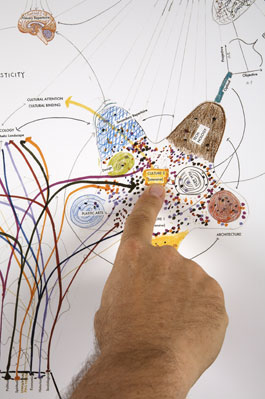
My finger, like a mouse on a computer screen, engages the drawing again now in a random walk through this information map and alights again on Culture 2 and then moves through a portal, into an area called The Secondary Repertoire just above and to its left. The Secondary Repertoire is a condition of the nervous system which results from its reaction to the environment, of which culture plays an important role. As a result of the conditions of intrauterine development and the genetic contribution of your mother and father, the brain, at birth, is made up of elements that are ready to operate in any environment that the baby might find itself. These, you might say, are pre-determined, like the sucking reflex and the beginnings of sight. I might say, however, that this Determined Brain is very underdeveloped compared to, for instance, a baby horse, that at birth can already walk. Nonetheless, there is also a Becoming Brain, one that has a potential to be modified. A brain in which large areas have not yet been organized and that are ready to meet the specific demands, within reason, that it is born into. According to neuroscientist Gerald Edelman, in his book, co-authored with Giulio Tononi, A Universe of Consciousness, the brain is made up of a large population of variable nervous elements some of which can become selected by the conditions of the world that it finds itself in. Neurons -the basic building blocks of the nervous system and neural networks- that are selected, operate more efficiently than those not selected for and, accordingly, will out-compete others for the confined and limited space of the brain. The process of, for instance, neural selectionism, combined with the brain’s inherent potential for change, called Neural Plasticity, allows for a sculpting of the brain. Each culture provides a metaphor for that sculpting, whether it is the Figurations of Rodin, the Scatter Art of Barry Le Vay or the cacophonous meanderings of Jason Rhodes that call out to the brain in different ways, intensifying different networks and currents and diminishing others. D.O. Hebbs in his famous book of 1949, The Organization of Behavior, states that “neurons that fire together wire together.” in this context, this adage becomes “Network conditions in the Real-Imaginary-Virtual Interface sculpt Network Conditions in the Brain.” These new forms of interconnection reflect the cultural conditions and the immaterial relations, as we already saw, produce it. The mutating conditions of the assemblage of Networks as they are produced by the mutating conditions of culture create new dynamic pathways for thought and the imagination. In fact, each culture produces what Deleuze called ‘noo-ology,’ the history of the Thought Image through its inflection in the intergenerational conditions of the selected brain and the psychological and philosophical thoughts that emerge.
As we have mentioned already, Culture 2 directly contacts the Secondary Repertoire through a portal cut in the flesh of the diffuse milieu of Cultured Brain Drawings Microscopy. It is connected to the Primary Repertoire from which it emerges. The pleuripotential Primary Repertoire is the brain at birth or shortly before. It is the end point of Develpmental Selection, which we mentioned above, and produces the variable population of neurons that Culture 2 can now act upon. It is a node that indirectly connects the other parts of the drawing; to its upper right the Earthling Drawing and to the left the Becoming Brain. The Earthling Drawing delineate the conditions of the unconscious and the pre-individual, where the new logics of global Capitalism, according to Antonio Negri and Maritzio Lazzarato, are now focused. In the transformation of labour to its current Post-Fordist condition, noo-politics, namely the ensemble of techniques of control exercised on the brain and aimed at memory and attention is the order of the day. Through the ‘distribution of sensible’, the partage du sensible as Jacques Ranciere has defined it in The Politics of Aesthetics, sovereignty creates a series of laws and dispositions that establishes the modes of perception, that is, the set of perceptual horizons, a system of self-evident facts of perception that delineate what can be heard, said, made and done. Those distributions are very different in an Intensive Culture and in an Extensive Cuture. The order and sequencing of those stimuli, especially as they are generated in built space, have implications for the history of the thought image and the becoming brain. In the present Intensive Global Culture, the expanded role of capital in the generation of the general intellect consortiums of media giants, cognitive neuroscientific research assemblages, the military, advertising firms, polling interests consciously or unconsciously have littered Cultural Visual/Haptic Landscape with very sensational stimuli. Paul Virilio has labeled these processed and engineered stimuli Phatic Stimuli to draw attention to their conditions of Emphasis and Empathy, which are produced to call out to the brain and mind of the multitude. Branding would be an example of such a Phatic Stimuli, especially as they circulate in the real abstract conditions of billions of televisions and computer desktop terminals. In the expanded condition of thousands of these phatic stimuli operating together in immanent assemblages forming intensive networks of phaticity, a simulated ecology of meaning becomes possible. This intensive environment is now what calls out to the brain and preferentially selects neurons and neural nets according to its logic. This is one condition of the Earthling as a new Global Subject in the production of the people of the planet Earth. But there is another story.
In their most Utopian sense artist, architects, designers, writers and cinematographers, just to name a few, utilize there own methods, apparati, histories, spaces, performances to produce another distribution of the sensible, a Redistribution of the Sensible, that competes with that of the aforementioned Institutional Conditions for the attentions and memories of the multitude. This is the real story of the Earthling Drawing. Art as a form of resistance in which the form(s) of the Distributed Sensibility is the conceptual palate through which new forms of imagination with their potential for difference are transfigured.
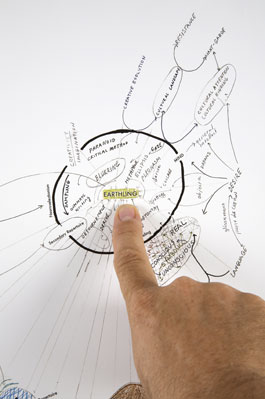
The diffuse logic of my now unconscious finger searching for the intense psycho-geographic spaces finds itself, through diagonal and lingering gestures, in the cyclic looped Earthling Drawing. Here is where the dynamis of subjectivity is produced; where the pre-individuals of the singularities reside. Embedded in a spinning vortex of energy relations are a history of forms of that resistance to institutional norms, which constitute the homogeneity of the people. Practices like The Paranoid Critical Method of Salvador Dali, the channeling and theater of cruelty of Antonin Artaud, the Ready-made of Duchamp, the Derive of Gilles Debord, the collage of John Heartfield, the automatic writing of Andre Breton which produce new objects, object relations, space, reactions and virtuoso performances. To these practices could be added the Race, Gender and Class-Based practices that have become critically important in the past forty years. Here, the work of Mary Kelly, Andrea Fraser, Felix Gonzales Torres, Fred Wilson and Valie Export come to mind. These new conditions of the distribution of sensibility, now populated by these other objects emanating from quite different conditions, cause perturbations in the Institutional Diagram and produce adjustment of the minds eye as it scans the visual, auditory and haptic landscape in its daily routines. Through the same process of Neural Selectionism and its affect on the primary repertoire new connections are built; an other Cultured Brain. As such, attention and memory, the building blocks of the conscious and unconscious, are undeniably affected as well. As the world of imagination and fantasy creates the internally mediated stimulation of those and other circuits, neural sculpting and the mind will, though various feed-forward and feedback looping, be affected. Sovereignty in the age of controlling the mind at a distance is hip to the contingencies of the possibility of culture as its competitor. The new war on culture and the differences it produces is taking many forms. From the reduction of funding, to the extended power of the market place, to the new interest in the funding of the what are referred to as the cultured industries, Sovereignty is doing all it can to usurp the power of the artist.
